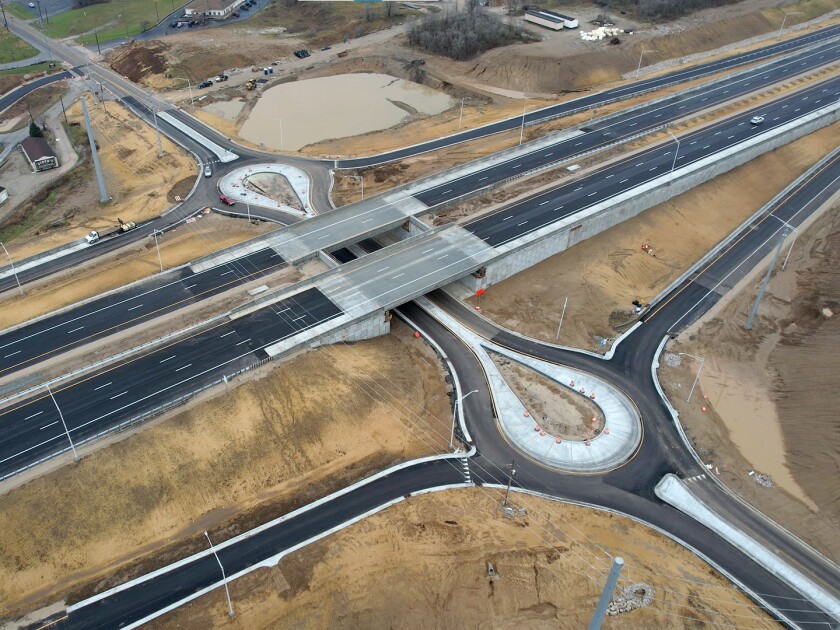In Brief:
Vaneta Becker’s commute takes longer than most Hoosiers’. For more than 40 years, she’s been making the drive from her home in Evansville to the state Capitol in Indianapolis, where she’s served in the state legislature since 1981. It used to be a three-and-a-half-hour trip, but the gradual development of Interstate 69 in southern Indiana has made it much faster. The “naysayers” warned it would only save 10 minutes, Becker recalls. Actually, it saves her an hour each way.
The Indiana Department of Transportation (INDOT) is now putting the finishing touches on the state’s sections of I-69, expecting to complete the long-planned road by the end of the year. The section that stretches from Indianapolis north to Port Huron, Mich., on the border with Canada, was originally opened in 1992. But the portion of I-69 south of Indianapolis didn’t really get going until 2005.
Eventually, it’s planned to run clear from Canada to Mexico, connecting Michigan, Indiana, Kentucky, Tennessee, Mississippi, Arkansas, Louisiana and Texas. Indiana officials argue the completion of the highway in Indiana lifts the fortunes of the cities along its route, and cements the state’s identity as the “Crossroads of America.”
“It has a very positive effect on the entire state,” says state Sen. Rodric Bray, like Becker a Republican. “It’s something we’ll end up taking a lot of pride in.”
Linking Economic Centers
Although the system was a national project, the highways themselves are built and maintained by individual states, with the federal government supplying the bulk of the funding. Building out the portion of I-69 in southwest Indiana “was a discussion that was had for many years,” says Tim Miller, a vice president with HNTB, the infrastructure firm that is managing the final segment of the project.
The interstate was built on the path of some existing roads and involved building wider lanes on some state routes and eliminating crossings with other roads. “I think the primary benefit is safety,” Miller says. “Some of the roads and the infrastructure in southwest Indiana, we want to provide them with the same amount of safety as other parts of the state. So safety was a major component, as well as that economic opportunity in what an interstate provides.”

Paying for the Road
Researchers and advocates still debate the costs and benefits of building new highways in the U.S., but state and federal transportation agencies have long considered them important investments in economic growth. Reducing the time it takes to travel between economic centers boosts productivity, they say. And connecting rural communities to the capital gives people more meaningful access to their state government, says Becker.
There was lots of talk but little action between the completion of I-69 in northern Indiana and the start of the southern section, she says. Still, she and other lawmakers pushed a series of governors to make it a priority. “We had to keep it on the front burner,” Becker says. “A lot of people thought ‘Oh God, we’ll never see it in our lifetime.’”
The project finally got underway under former Gov. Mitch Daniels. His administration leased the Indiana Toll Road, which hugs the northern border of the state, to a foreign company to maintain and operate for 75 years. The state then used the proceeds of that sale to invest back into transportation infrastructure, including the southern stretch of I-69. In the years that followed, the company struggled to keep up with its debt service, and the deal is now often thought of as an “overpayment” that worked in the state’s favor.
The road has been built in segments, each with a slightly different financing structure. One section, between Bloomington and Martinsville, began construction through a public-private partnership when former Vice President Mike Pence was governor. The setup was meant to mix the efficiency of the private sector with the cheaper financing available to state governments, as well as to transfer some risk away from the public. But the company fell behind schedule, and the state dissolved the partnership.
Some researchers argue the episode shows that there’s only so much risk that can be shifted to a private entity in a public infrastructure project. “The state is always ultimately responsible, no matter how expensive it may be, to clean up the mess,” says Kevin DeGood, director of infrastructure policy at the left-leaning Center for American Progress. “Voters hold politicians accountable, not contractors, for finishing the projects they promised.”
Facing the Finish Line
The Indiana Department of Transportation says it’s on track to finish the interstate entirely by the end of 2024. Recent disruptions, like the onset of the COVID-19 pandemic, actually resulted in the state being able to finish the project more quickly.
“Everyone was at home,” says Sarah Rubin, a project delivery support director at INDOT. “Our construction team was actually, from a maintenance-of-traffic perspective, in a safer situation because of the lower volumes of traffic.”
The state also signed its final contracts in the months leading up to the pandemic, so the inflation of labor and material costs of the last several years haven’t affected the overall cost much, project planners say. The department is now finishing the sixth and final segment of I-69 in Indiana, which it’s calling the I-69 Finish Line.
Rubin says communicating regularly with the public throughout the planning and construction process helped keep the segment on track. Even when people were annoyed by traffic disruptions, they felt informed and invested in the highway’s completion, she says.
Becker, the state senator, says many of the people who fought to get the road financed and built have passed away. She's among those who wondered whether she'd live to see its completion.
But the road has already made her commute better, and she believes it will create new opportunities for all the small cities and towns along its path for decades to come. “It’s been very much worth all the advocacy," she says, "because it was not an easy thing to accomplish."











